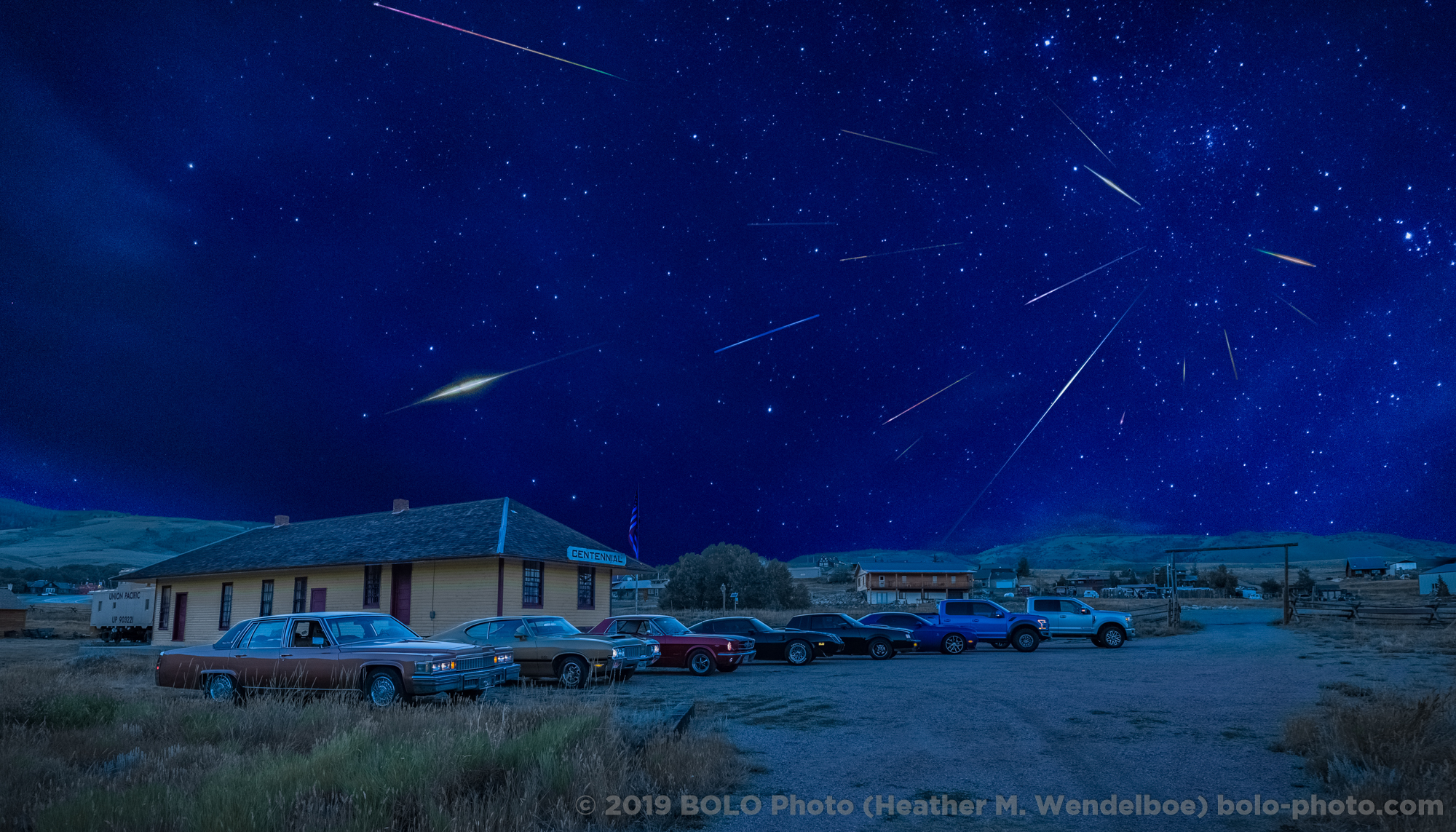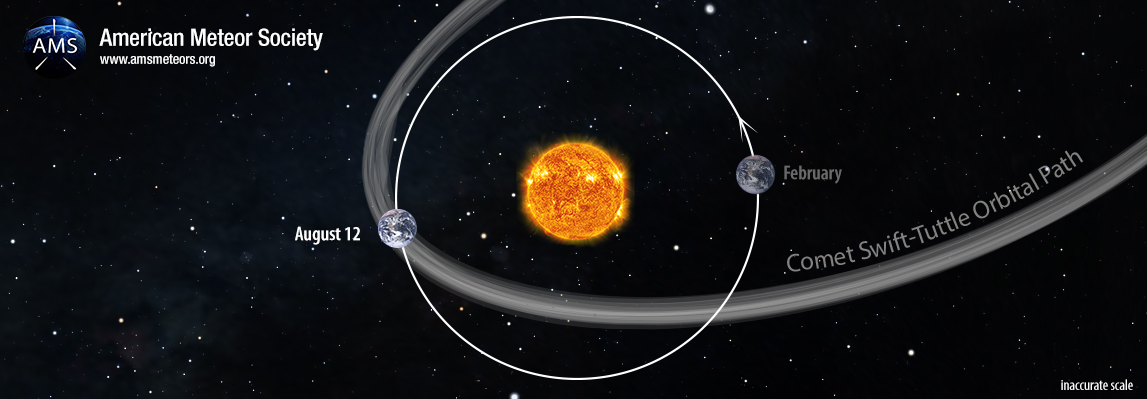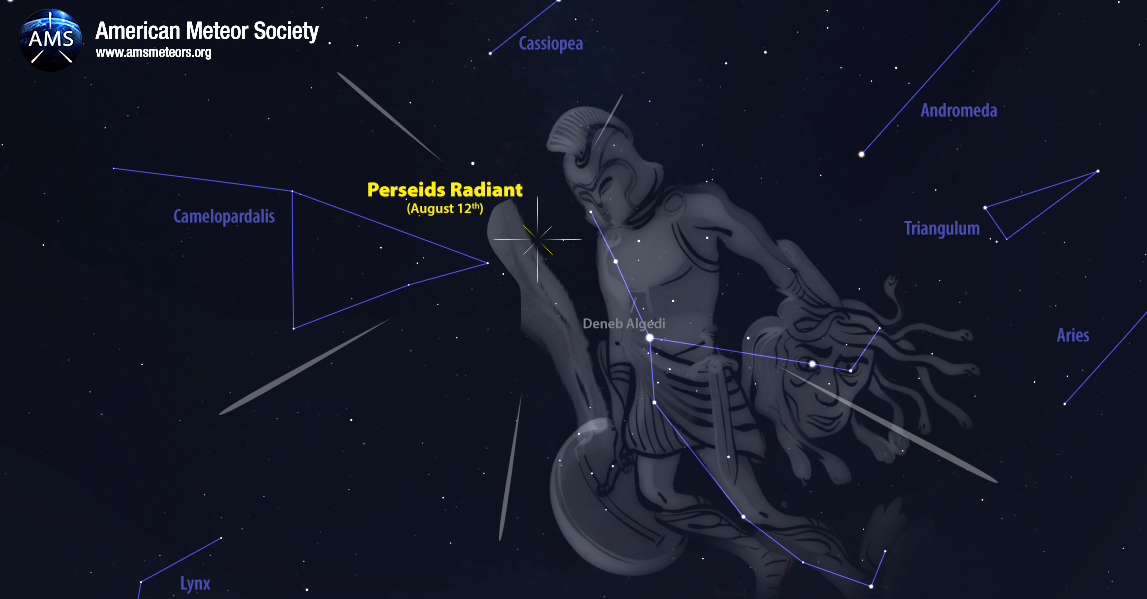
The Perseids are often the most impressive Meteor Shower of the year for the Northern Hemisphere. The Perseid meteor shower offers a consistently high rate of meteors every year and it occurs in August when the temperatures are usually nice enough for a night under the stars!
Comet Dust
Each July and August the Earth encounters debris left behind from comet 109P/Swift-Tuttle. This comet has an orbit of 133 years and last entered the inner solar system in 1992. Even though the comet now lies in the outer portions of the solar system, far away from Earth, we still encounter debris that has been left behind during the many trips this comet has made through the solar system.
This meteor shower is perhaps the most popular as it is active during the summer months in the northern hemisphere. There are stronger meteor showers but they appear during the colder time of year in the northern hemisphere when conditions are less inviting. The strength of each Perseid display varies year to year, mainly due to lunar conditions. If a bright moon is above the horizon during the night of maximum activity, then the display will be reduced. Most of the Perseid meteors are faint and bright moonlight will make it difficult to view. Luckily, in 2021, the moon is a waxing crescent on the night of maximum activity, which means the moon will set during the late evening hours, leaving the more active morning hours free of moonlight. In 2022, when the Perseids reach maximum strength, the moon will be just past its full phase and will obscure all but the brighter meteors. This will reduce visual activity by at least 75 percent. Therefore don’t miss this opportunity to view the Perseids this year under idea conditions!
August 11th/12th or 12th/13th?
To view the Perseids at their best, you need to know when to watch. As seen from the Northern Hemisphere, during the evening hours the radiant, the area of the sky where Perseid meteors shoot from, is located low in the northern sky. This is the worst time to try and view the shower for sheer numbers as most of the activity will occur beyond your line of sight, being blocked by the horizon. But the few that do come your way this time of night are special. The reason is that they just skim the upper regions of the atmosphere and will last much longer than Perseids seen during the morning hours. Since they last longer they also will travel a much longer distance across the sky. Most of these “earthgrazing” Perseids will be seen low in the east or west, traveling north to south. Occasionally one will pass overhead and will be unforgettable as you watch it shoot across the sky for several seconds. While these meteors are few, they are certainly worth the effort to try and catch. The moon may still be above the horizon at this time, but it will offer little interference to viewing these early Perseids.
As the Earth rotates and the time approaches local midnight, the Perseid radiant has risen higher into the northeastern sky. The meteors are now shorter and last only a few tenths of a second. You still only see about half of the actual activity as the remainder still occur beyond your line of sight. As the morning progresses, the activity will increase as the radiant climbs higher into the sky. Theoretically, the best time to watch the Perseids is just before the break of dawn when the radiant lies highest in a dark sky. This is usually around 04:00 local time. Experienced observers often say the hour between 03:00 and 04:00 is usually the best, not 04:00 to 05:00. Perhaps this is due to fatigue as experienced observers have watched for several hours by then and may have trouble staying alert.
 In 2021, the strongest Perseid rates are expected to occur near 19:30 Universal Time on August 12th. For those living in Asian longitudes the morning of August 13th should provide the strongest activity. In Europe and Africa, this timing falls during the evening hours of August 12 so again the morning hours of August 13 should provide the strongest activity. North America lies between the two dates as 19:30 UT occurs during the afternoon hours. Therefore Perseid activity should be similar on both the mornings of August 12 and 13. Also from North America, the evening of August 12 should be more active than the 11th. If at all possible view the meteor activity on several nights (August 10-14) as these nights provide more meteor activity than 95% of the other calendar dates throughout the year.
In 2021, the strongest Perseid rates are expected to occur near 19:30 Universal Time on August 12th. For those living in Asian longitudes the morning of August 13th should provide the strongest activity. In Europe and Africa, this timing falls during the evening hours of August 12 so again the morning hours of August 13 should provide the strongest activity. North America lies between the two dates as 19:30 UT occurs during the afternoon hours. Therefore Perseid activity should be similar on both the mornings of August 12 and 13. Also from North America, the evening of August 12 should be more active than the 11th. If at all possible view the meteor activity on several nights (August 10-14) as these nights provide more meteor activity than 95% of the other calendar dates throughout the year. To view the Perseids successfully, it is suggested you watch from a safe rural area that is as dark as possible. The more stars you can see, the more meteors will also be visible. No matter the time of night, Perseid meteors can be seen in all portions of the sky. No matter which direction you look, it is advisable to aim your center of view about half-way up in the sky. Don’t look straight up as more activity is visible at lower elevations. Some observers like to view toward the constellation Perseus and the radiant. This way they can see Perseid meteors travel in all directions. The disadvantage of viewing in this direction is that the Perseid meteors will be short, especially near the radiant. The other choice is to face away from the radiant and witness longer meteors, which are more impressive. Even if the radiant is at your back, you can still distinguish Perseid meteors from others as they will all travel in the same parallel paths and will have similar velocities.

Share!
While viewing this meteor shower we encourage observers to contribute data to our organization by counting the number of meteors seen during a specific time range and sharing that data with us. A period of at least an hour is suggested as meteor displays are notoriously variable. One can watch for 10 minutes and see no activity at all! Just a few minutes later several meteors may appear nearly simultaneously. To even out these “peaks and valleys” is why we ask for viewing periods of at least an hour. Not all meteors you see will be Perseids. There are other weak showers active during the Perseids plus there are many random meteors that occur each hour too. Separating these different meteors adds to the value of your data. It is also important to estimate the faintest star you can easily see by reporting a limiting magnitude. The faintest stars most observers can see from a rural location is around magnitude +6.0. Very dark sites can approach +7.0. Light polluted skies usually offer limiting magnitudes of +5.0 and lower. An estimate of your limiting magnitude will allow us to correct your data to a similar limiting magnitude so that all counts will be compared under similar conditions. Don’t forget to mention any clouds or obstacles that block your field of view. These will reduce your counts.
If you are experienced enough, we encourage you to share your observation to the International Meteor Organization. Helpful hints on how to do this are available here.
The bottom line is to have fun watching nature’s fireworks. If you can have fun and contribute data too, that helps us understand more about this phenomena.




 You saw something bright and fast? Like a huge shooting star? Report it: it may be a fireball.
You saw something bright and fast? Like a huge shooting star? Report it: it may be a fireball.  You counted meteors last night? Share your results with us!
You counted meteors last night? Share your results with us!  You took a photo of a meteor or fireball? You have a screenshot of your cam? Share it with us!
You took a photo of a meteor or fireball? You have a screenshot of your cam? Share it with us!  You caught a meteor or fireball on video? Share your video with us!
You caught a meteor or fireball on video? Share your video with us!
8 comments
Does the peak depend on which part of the world you are observing from? The morning of 12th in US is different from the morning of 12th in Middle East – or Europe.
Omer and All,
Thanks for asking this interesting question. Unlike some meteor showers, the Perseids peak lasts for many hours so that most of the world can get a view of good activity from this meteor shower. Anyone north of latitude 60 North will have trouble with twilight all night long and the Perseid radiant does not rise above the horizon for anyone located south of latitude 30 south. The remainder of the globe should see peak rates between 50-75 per hour under dark skies. So the answer to your question is yes, for 2021, those living in Asia and Australia will see their best rates on the morning of August 13th. For the remainder of the world, the 12th will offer the better activity. I should have made this clear in the article and will revise it.
Thank you a lot for clarification, I live in a latitude 37 North, I can see it but I thought that the best view is whenver the constellation is above the horizon, I have used stellarium for that and I it’s saying the best time in my region at 2am , August 12
Hola Robert. Excelente información. Muchas gracias. Veremos si el clima colabora. Saludos desde Costa Rica.
Hi Robert
Great article you have written which has contributed to my writing my own long overdue blog post on meteor showers. Contrary to popular belief we can see the Perseids in Northern Australia !
https://www.nightskysecrets.com.au/observing-meteor-showers/
Cheers
Ian
Was watching the shower early this morning (8/12) between local midnight and 1:30AM, here in Everett, WA. Skies were clear but with unusually high light pollution. Car dealerships. Using the main stars in Cassiopeia as a guide post, I observed 20 meteors at that brightness level. I did observe four much brighter streaks, having very short paths in the sky. Deep-diving meteors?
Good luck!
Excellent information. Hope all goes well
En mi caso realicé observaciones la noche del 14 de agosto, pero las condiciones meteorológicas no fueron las más óptimas. En lapso temporal de 3 horas, logré contar 35 meteoros, 3 bolas de fuego y 3 trenes de meteoros.
Fue una noche de baja intensidad.